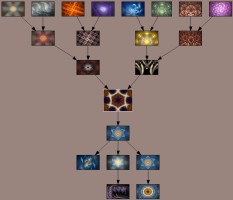November 26, 2006
Can a machine be made to be supercritical?
From Computing Machinery and Intelligence by A. M. Turing, which addresses the question "Can a machine do anything new?" Written in 1950, four years before he was driven to suicide by the attempt to "cure" his homosexuality with hormone "treatments".Let us return for a moment to Lady Lovelace's objection, which stated that the machine can only do what we tell it to do. One could say that a man can "inject" an idea into the machine, and that it will respond to a certain extent and then drop into quiescence, like a piano string struck by a hammer. Another simile would be an atomic pile of less than critical size: an injected idea is to correspond to a neutron entering the pile from without. Each such neutron will cause a certain disturbance which eventually dies away. If, however, the size of the pile is sufficiently increased, tire disturbance caused by such an incoming neutron will very likely go on and on increasing until the whole pile is destroyed. Is there a corresponding phenomenon for minds, and is there one for machines? There does seem to be one for the human mind. The majority of them seem to be "subcritical," i.e., to correspond in this analogy to piles of subcritical size. An idea presented to such a mind will on average give rise to less than one idea in reply. A smallish proportion are supercritical. An idea presented to such a mind that may give rise to a whole "theory" consisting of secondary, tertiary and more remote ideas. Animals minds seem to be very definitely subcritical. Adhering to this analogy we ask, "Can a machine be made to be supercritical?"thanks watson
Posted by spot at 04:29 AM
| Comments (1)
November 21, 2006
Sheep in Communication Arts magazine
The Electric Sheep are listed and reviewed in the latest Communication Arts magazine (not sure if it will be in print or only online) in an article titled "50 Essential Resources". It's in the side-bar under "Work and Play". The review says:...one of the most striking, beautiful examples of what humans can create with computers.Thank you CommArts and Smash!
Posted by spot at 09:38 PM
| Comments (0)
November 10, 2006
Lineages
 Yesterday I finally implemented something I had been thinking about for a long time:
local family trees. Every sheep now has a "lineage" menu that shows its
immediate ancestors and descendants, all clickable. It's much easier to navigate than
the global trees that the
server has generated for a long time.
Yesterday I finally implemented something I had been thinking about for a long time:
local family trees. Every sheep now has a "lineage" menu that shows its
immediate ancestors and descendants, all clickable. It's much easier to navigate than
the global trees that the
server has generated for a long time.
Posted by spot at 02:32 PM
| Comments (1)
November 08, 2006
Sheep on YouTube
I found this in this livejournal via Technorati. thanks! Turns out there are a number of sheep clips available, none posted by me: 1, 2, 3, 4, 5. There was one more that was from the Spotworks DVD without proper credit (it does say "electric sheep" though). But I lost the link and now I can't find it. huh. I wonder if they noticed my comment and took it down.
Posted by spot at 11:52 PM
| Comments (0)